An Improved Commutation Prediction Algorithm to Mitigate Commutation Failure in High Voltage Direct Current
Abstract
:1. Introduction
2. Commutation Failure
Influencing Factors of Commutation Failure
- (1)
- Increasing the γ angle in normal conditions, which will consume much more reactive power.
- (2)
- When a commutation failure is detected in an HVDC system, the inverter decreases the α angle in order to increase the commutation margin and avoid commutation failure.
3. Analysis of the Response of the Commutation Failure Prediction Method for TianZhong ± 800 kV Ultra High Voltage Direct Current Project
3.1. The Commutation Failure Prediction Method in an High Voltage Direct Current Project
3.2. The Performance of Commutation Failure Prediction During the Disturbance
3.3. Analysis of the Converter Bus Voltage
4. A Novel Commutation Failure Prediction Method Based on the Harmonic Characteristics of the Converter Bus Voltage
4.1. Harmonic Detection Based on the Sliding-Window Iterative Algorithm of Discrete Fourier Transformation (DFT)
4.2. A New Commutation Failure Prediction Method
5. Experiments and Results
5.1. To Reproduce the Process with the Traditional Commutation Failure Prediction Strategy
5.2. To Verify the Proposed Commutation Failure Prediction Strategy under the Same System Configuration
5.3. To Verify the Proposed Commutation Failure Prediction Strategy Under 1000 kV Ultra High Voltage Transformer Charging
5.4. To Verify the Proposed Commutation Failure Prediction Strategy in TuanLin-FengJing ± 500 kV High Voltage Direct Current
6. Conclusions
Acknowledgments
Author Contributions
Conflicts of Interest
Abbreviation
| γ | Extinction Angle |
| α | Firing Angle |
| Xr | Commutating Reactance |
| Id | Dc Current |
| E2m | Commutation Voltage |
| β | Trigger Advance Angle |
| IVY | YY Transformer Current in Valve Side |
| IVD | YD Transformer Current in Valve Side |
| CFPREV | Commutation Failure Prediction |
| α_CFPREV | The Output of CFPREV |
| u0 | Zero Sequence Component |
| uα | uαβ in α axis |
| uβ | uαβ in β axis |
| uαβ | The Magnitude of Rotating Vector |
| ua, ub, uc | Three-phase Instantaneous Voltage of Converter Bus |
| Uac_COMP | Magnitude of Uac Before Fault |
| Ncur | The Latest Sampled Data Points |
| x(iτ) | Sampling Data Before i Sampling Period |
| TianZhong | TianShan-ZhongZhou |
| UHVDC | Ultra High Voltage Direct Current |
| DFT | Discrete Fourier Transform |
| FFT | Fast Fourier Transformation |
| CFPREV_Harm | The output of CFPREV based on harmonic detection |
| Uac_Harm_Blk | Action signal of CFPREV based on harmonic detection |
| RTDS | Real-time Digital Simulator |
| HP | High-pass Filter |
| BP | Band-pass Filter |
| SC | Shunt Capacitor |
References
- Bidadfar, A.; Nee, H.-P.; Zhang, L.; Harnefors, L.; Namayantavana, S.; Abedi, M.; Karrari, M.; Gharehpetian, G.B. Power System Stability Analysis Using Feedback Control System Modeling Including HVDC Transmission Links. IEEE Trans. Power Deliv. 2016, 31, 116–124. [Google Scholar] [CrossRef]
- Pirooz Azad, S.; Iravani, R.; Tate, J.E. Dynamic Stability Enhancement of a DC-Segmented AC Power System via HVDC Operating-Point Adjustment. IEEE Trans. Power Deliv. 2015, 30, 657–665. [Google Scholar] [CrossRef]
- Zhang, X.; Lu, C.; Xie, X.; Dong, Z.Y. Stability Analysis and Controller Design of a Wide-Area Time-Delay System Based on the Expectation Model Method. IEEE Trans. Smart Grid 2016, 7, 520–529. [Google Scholar] [CrossRef]
- He, J.; Tang, Y.; Zhang, J.; Guo, Q.; Yi, J.; Bu, G. Fast Calculation of Power Oscillation Peak Value on AC Tie-Line After HVDC Commutation Failure. IEEE Trans. Power Syst. 2015, 30, 2194–2195. [Google Scholar] [CrossRef]
- Zhang, J.; Wu, Z.; Hu, T.; Zhang, W. Research on Coordinated Control Technology for AC/DC hybrid system in China. In Proceedings of the IEEE PES Transmission and Distribution Conference and Exposition, Chicago, IL, USA, 14–17 April 2014; pp. 1–5. [Google Scholar]
- Li, M. Characteristic Analysis and Operational Control of Large-Scale Hybrid UHV AC/DC Power Grids. Power Syst. Technol. 2016, 40, 985–991. [Google Scholar]
- Thio, C.V.; Davies, J.B.; Kent, K.L. Commutation failures in HVDC transmission systems. IEEE Trans. Power Deliv. 1996, 11, 946–957. [Google Scholar] [CrossRef]
- Wang, J.; Liang, Z.; Jiang, M.; Hu, C.; Ge, R. Case Analysis and Simulation of Commutation failure in Multi-infeed HVDC Transmission Systems. Autom. Electr. Power Syst. 2007, 31, 97–102. (In Chinese) [Google Scholar]
- Rahimi, E.; Gole, A.; Davies, B.; Fernando, I.; Kent, K. Commutation failure analysis in multi-infeed HVDC systems. IEEE Trans. Power Deliv. 2011, 26, 378–384. [Google Scholar] [CrossRef]
- Wei, Z.; Yuan, Y.; Lei, X.; Wang, H.; Sun, G.; Sun, Y. Direct-Current Predictive Control Strategy for Inhibiting Commutation Failure in HVDC Converter. IEEE Trans. Power Syst. 2014, 29, 2409–2417. [Google Scholar] [CrossRef]
- Guo, C.; Liu, Y.; Zhao, C.; Wei, X.; Xu, W. Power Component Fault Detection Method and Improved Current Order Limiter Control for Commutation Failure Mitigation in HVDC. IEEE Trans. Power Deliv. 2015, 30, 1585–1593. [Google Scholar] [CrossRef]
- Son, H.-I.; Kim, H.-M. An Algorithm for Effective Mitigation of Commutation Failure in High-Voltage Direct-Current Systems. IEEE Trans. Power Deliv. 2016, 31, 1437–1446. [Google Scholar] [CrossRef]
- Xue, Y.; Zhang, X.-P.; Yang, C. Elimination of Commutation Failures of LCC HVDC System with Controllable Capacitors. IEEE Trans. Power Syst. 2016, 31, 3289–3299. [Google Scholar] [CrossRef]
- Li, Y.; Liu, F.; Luo, L.; Rehtanz, C.; Cao, Y. Enhancement of commutation reliability of an HVDC inverter by means of an inductive filtering method. IEEE Trans. Power Electron. 2013, 28, 4917–4929. [Google Scholar] [CrossRef]
- Guo, C.; Li, C.; Zhao, C.; Ni, X.; Zha, K.; Xu, W. An Evolutional Line-Commutated Converter Integrated With Thyristor-Based Full-Bridge Module to Mitigate the Commutation Failure. IEEE Trans. Power Deliv. 2017, 32, 967–976. [Google Scholar] [CrossRef]
- Sun, Y.Z.; Peng, L.; Ma, F.; Li, G.J.; Lv, P.F. Design a fuzzy controller to minimize the effect of HVDC commutation failure on power system. IEEE Trans. Power Syst. 2008, 23, 100–107. [Google Scholar] [CrossRef]
- Hansen, A.; Havemann, H. Decreasing the commutation failure frequency in hvdc transmission systems. IEEE Trans. Power Deliv. 2000, 15, 1022–1026. [Google Scholar] [CrossRef] [Green Version]
- Tamai, S.; Naitoh, H.; Ishiguro, F.; Sato, M.; Yamaji, K.; Honjo, N. Fast and predictive HVDC extinction angle control. IEEE Trans. Power Syst. 1977, 12, 1268–1275. [Google Scholar] [CrossRef]
- Jovcic, D.; Pahalawaththa, N.; Zavahir, M. Investigation of the use of inverter control strategy instead of synchronous condensers at inverter terminal of an HVDC system. IEEE Trans. Power Deliv. 2000, 15, 704–709. [Google Scholar] [CrossRef]
- Lin, L.; Zhang, Y.; Zhong, Q.; Liao, Z. Studies of Commutation Failures in HVDC System Based on Hypersim. In Proceedings of the 2006 International Conference on Power System Technology, Chongqing, China, 22–26 October 2006; pp. 1–7. [Google Scholar]
- Zhang, L.; Dofans, L. A novel method to mitigate commutation failures in HVDC systems. In Proceedings of the 2002 International Conference on Power System Technology, Kunming, China, 13–17 October 2002; pp. 51–56. [Google Scholar]
- Lv, P.; Li, X.; Chen, L.; Yin, Y. A new method of preventing commutation failure in HVDC based on sin-cos components detection. In Proceedings of the International Conference on Electrical Engineering, YongPyong, Korea, 9–13 July 2006; pp. 2–11. [Google Scholar]
- Li, X.; Chen, X.; Li, T.; Wang, J. Research on the periodic commutation failure by 1000 kV UHV Transformer energizing for LinFeng HVDC project. Power Syst. Technol. 2014, 38, 2671–2679. [Google Scholar]
- Tong, Y. Harmonics in excitation inrush process of large power transformer and its magnification in network. Power Syst. Technol. 1995, 19, 28–31. [Google Scholar]
- Han, Z.; Guo, S. New Method to identify inrush current based on half wave Fourier analysis. Autom. Electr. Power Syst. 2005, 29, 60–63. [Google Scholar]

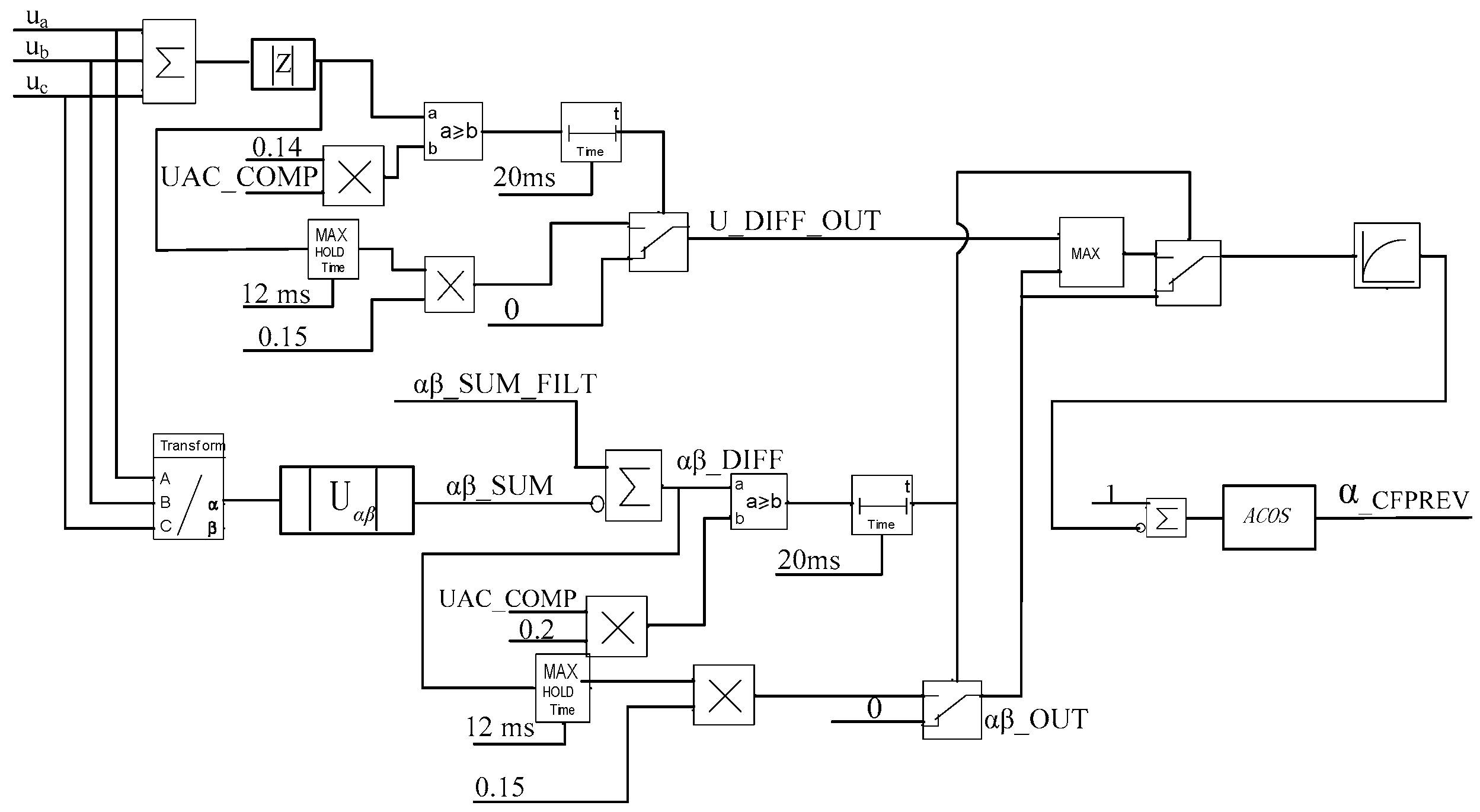
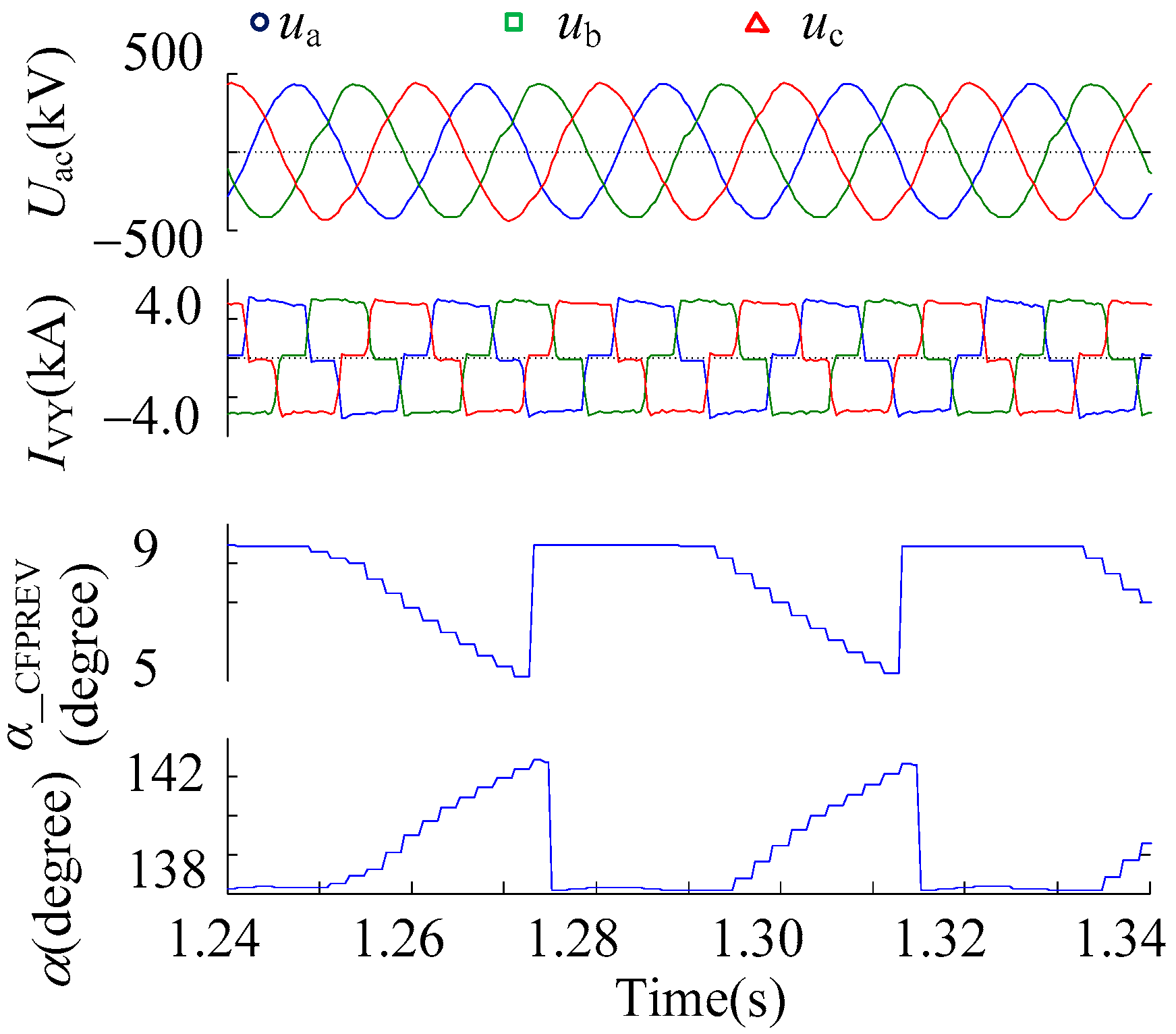
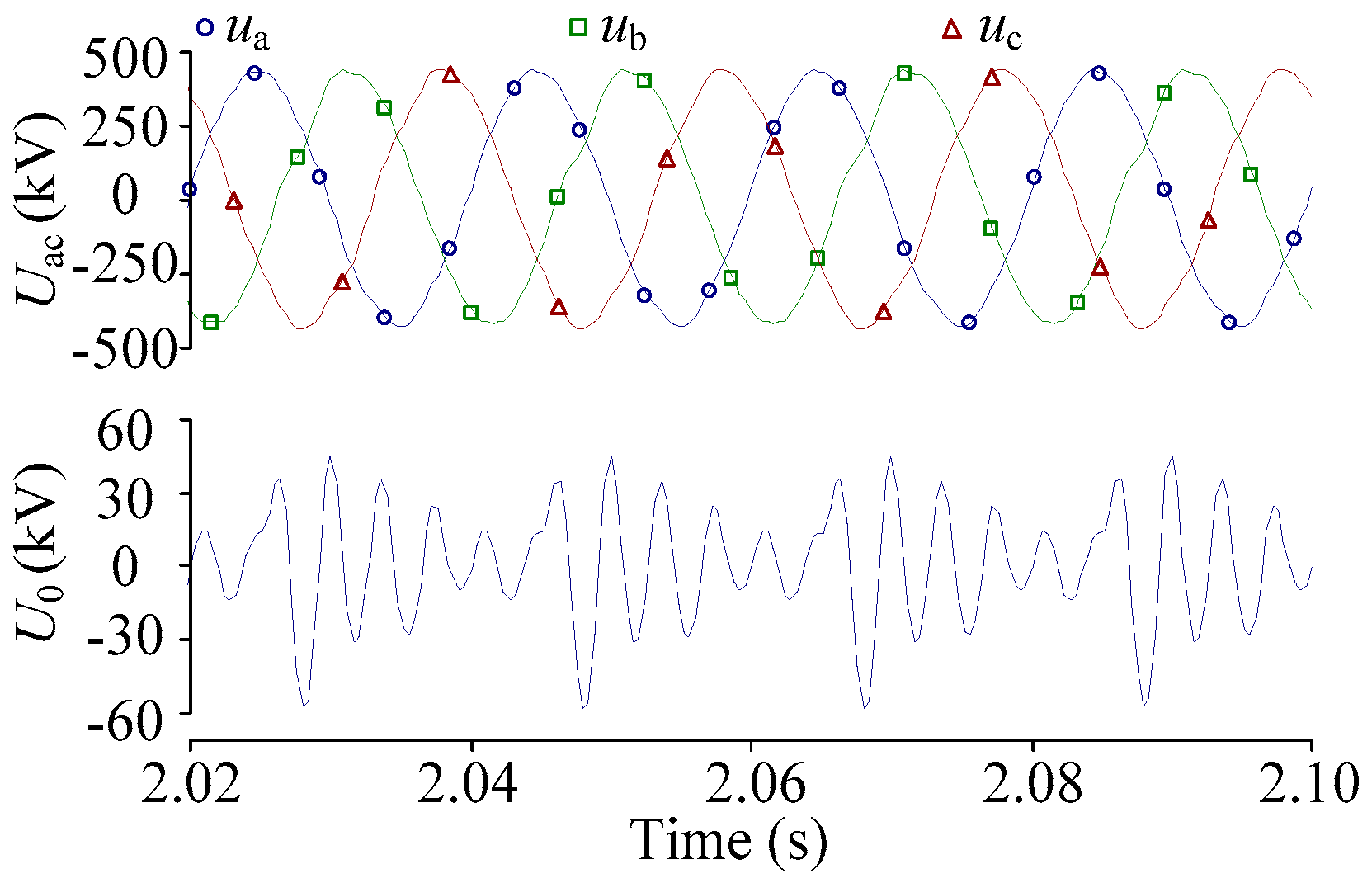
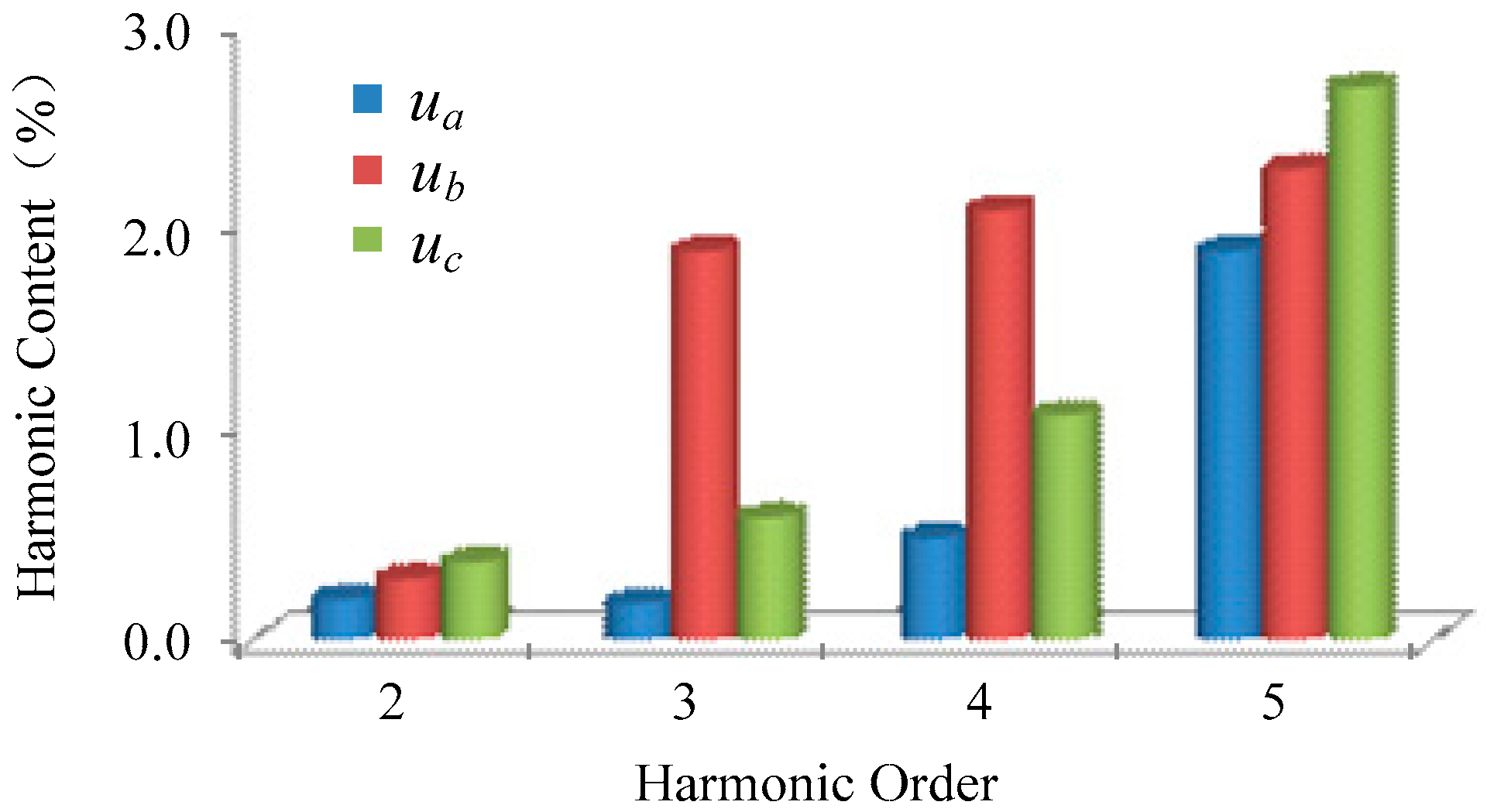

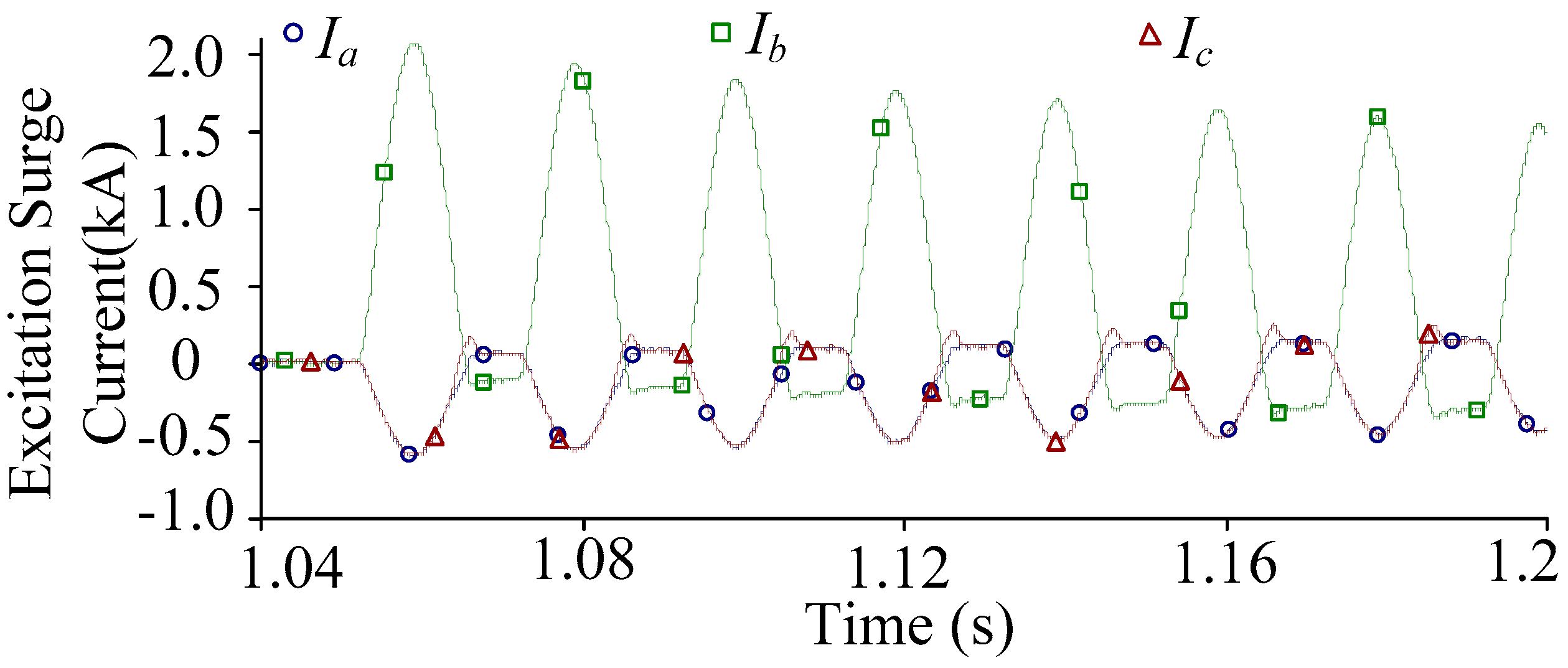
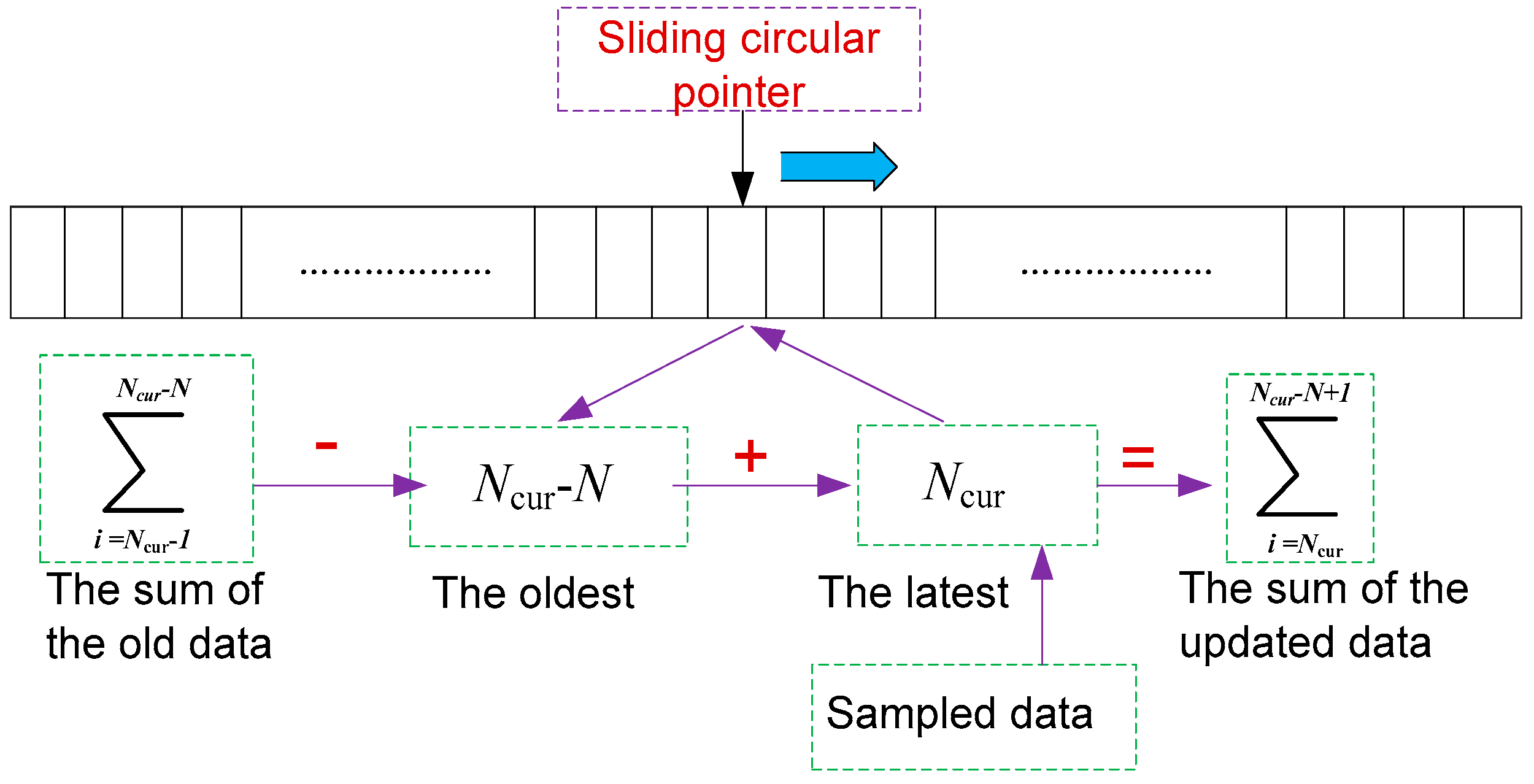
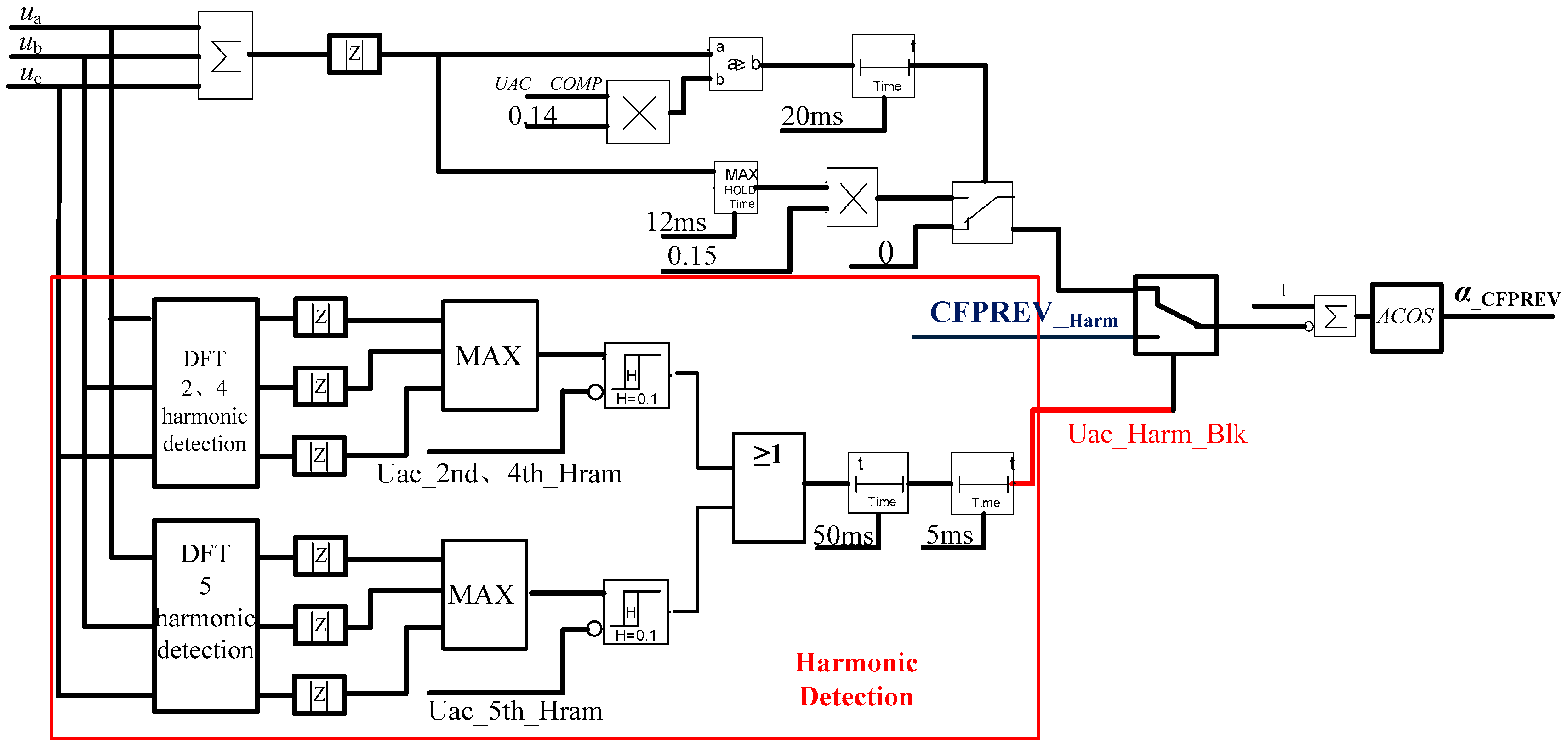
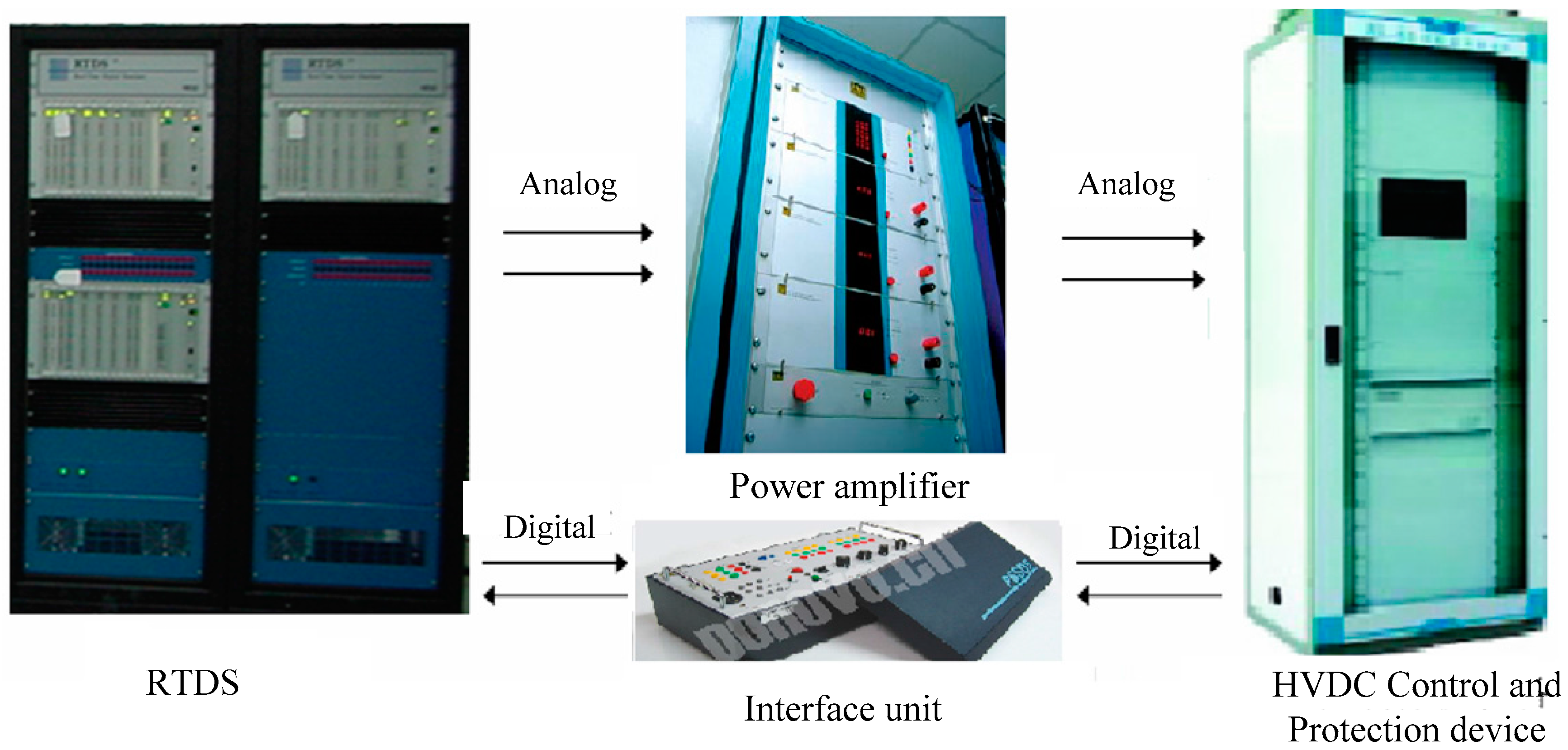
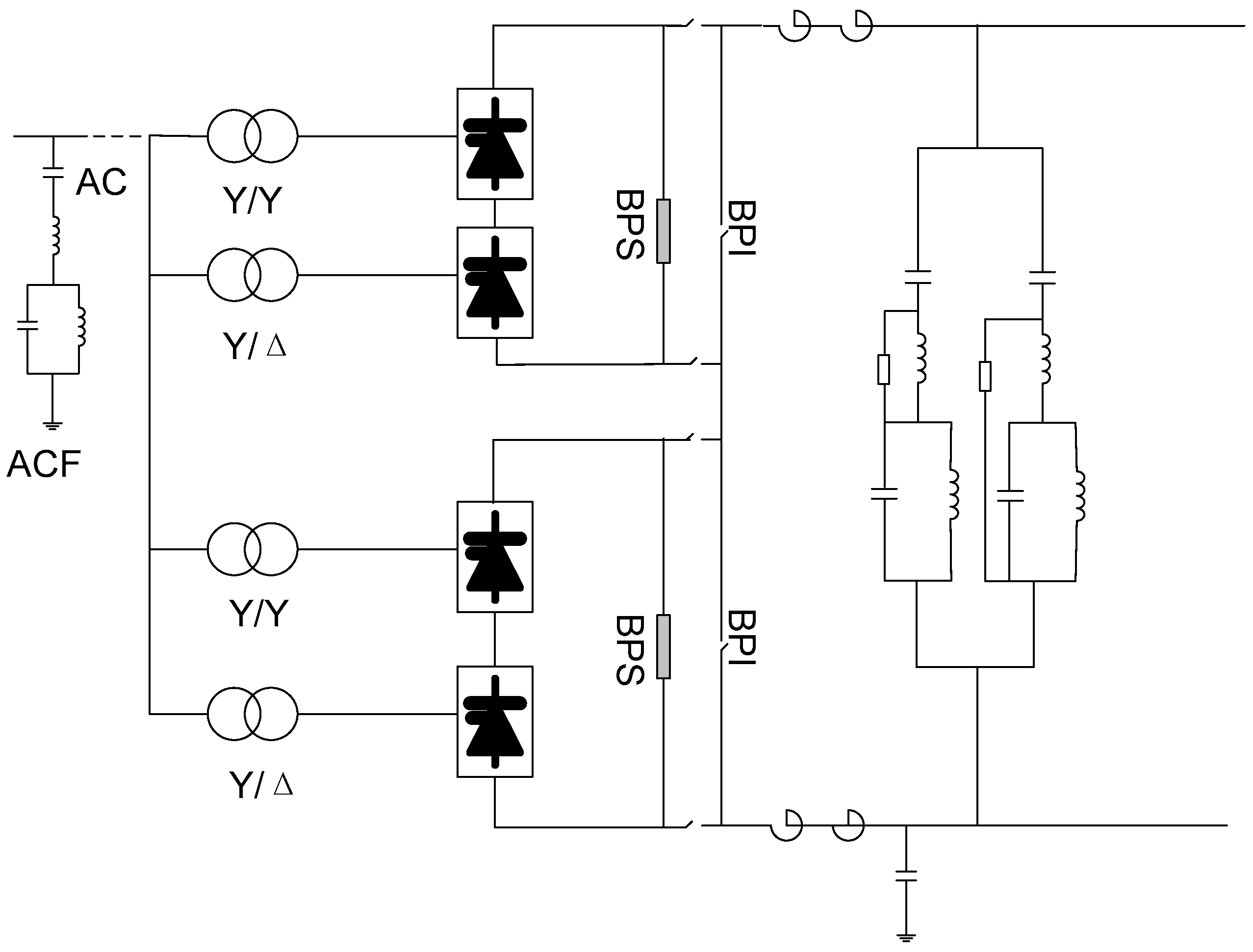
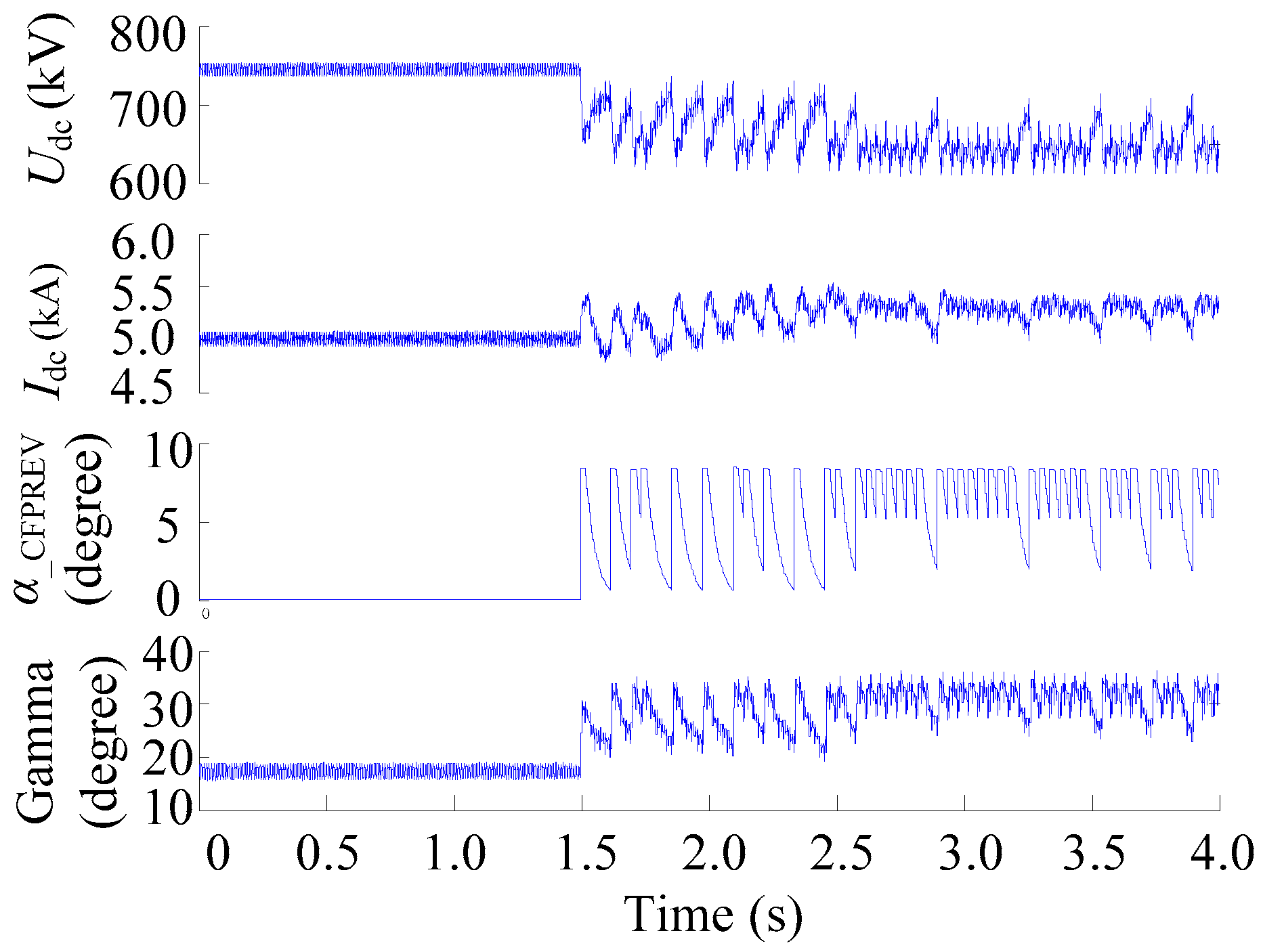

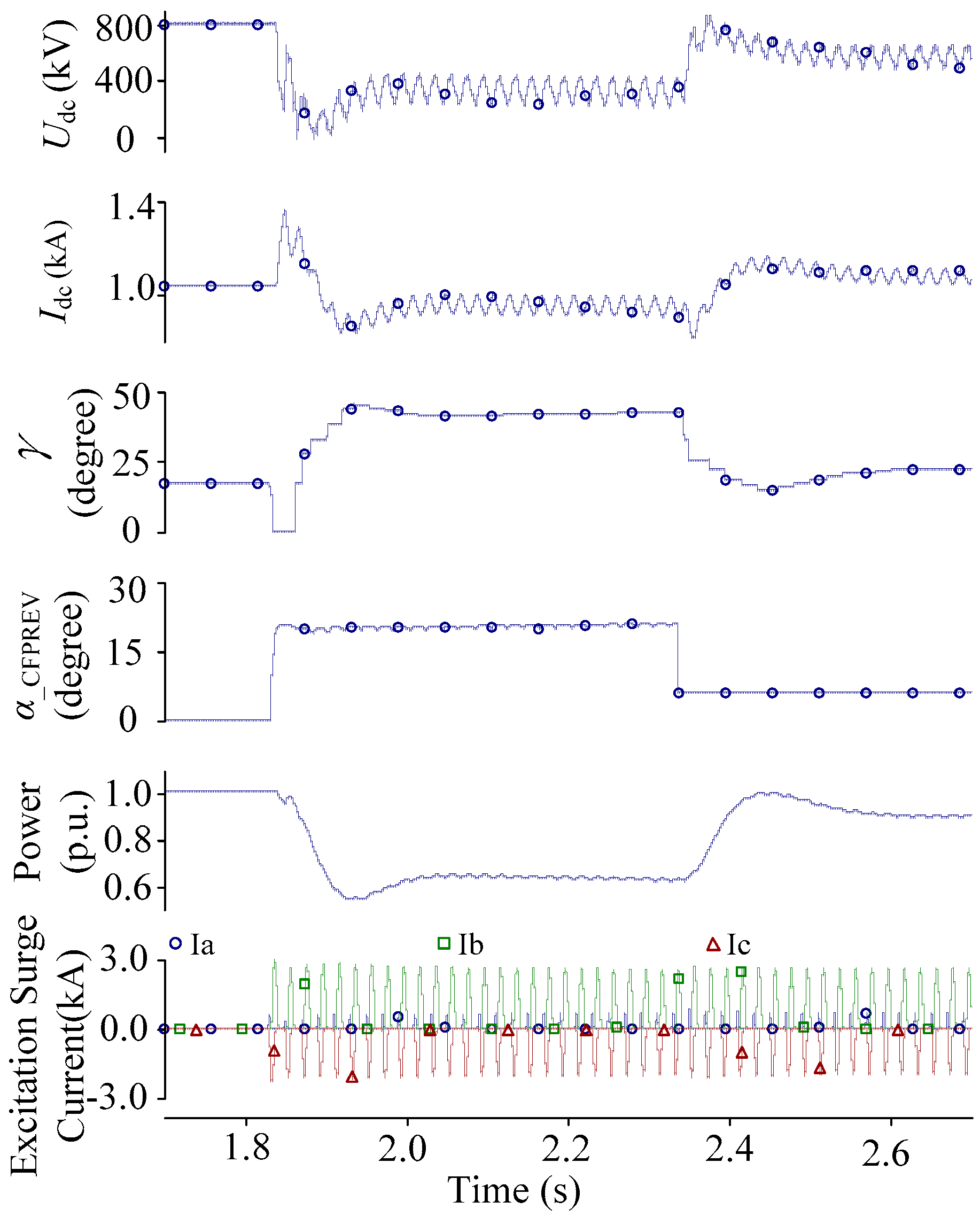
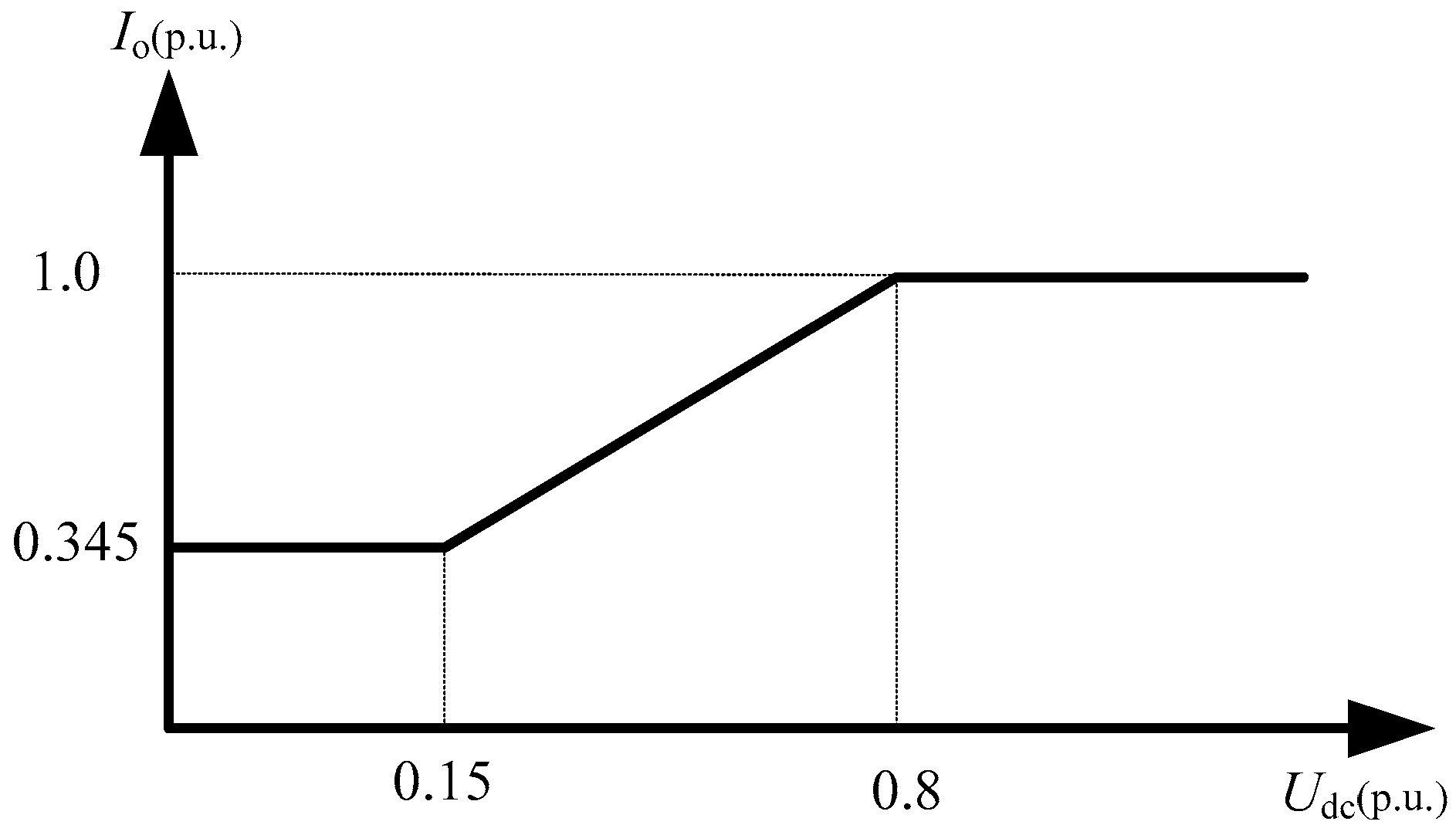

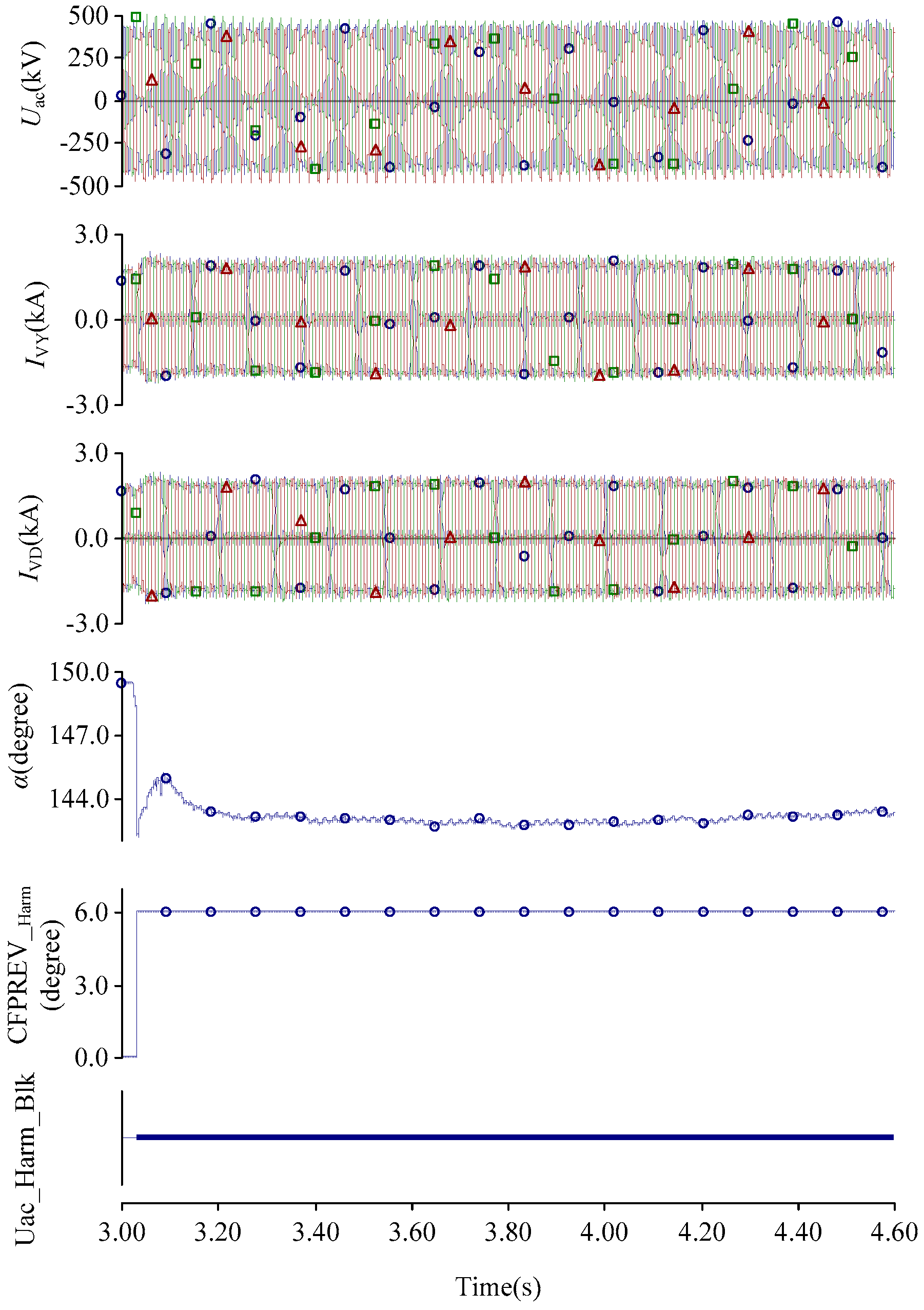
| Serial Number | Items | Units | Parameters |
|---|---|---|---|
| 1 | Bipolar rated power | MW | 8000 |
| 2 | Rated voltage | kV | 800 |
| 3 | Rated current | kA | 5.0 |
| 4 | Rated firing angle at rectifier | ° | 15 |
| 5 | Rated extinction angle at inverter | ° | 17 |
| 6 | Smoothing reactor | mH | 6 × 50 |
| 7 | the commutating reactance | % | 24 |
| 8 | The distance of DC lines | km | 2192 |
| Items | Location | Type |
|---|---|---|
| DC filter | TianShan | 1*HP2/39, 1*HP12/24 |
| ZhongZhou | 1*HP2/39, 1*HP12/24 | |
| AC filter | TianShan | 4*BP11BP13, 4*HP24/36, 3*HP3,5*SC |
| ZhongZhou | 8*HP12/24, 2*HP3, 9*SC |
© 2017 by the authors. Licensee MDPI, Basel, Switzerland. This article is an open access article distributed under the terms and conditions of the Creative Commons Attribution (CC BY) license (http://creativecommons.org/licenses/by/4.0/).
Share and Cite
Li, X.; Li, F.; Chen, S.; Li, Y.; Zou, Q.; Wu, Z.; Lin, S. An Improved Commutation Prediction Algorithm to Mitigate Commutation Failure in High Voltage Direct Current. Energies 2017, 10, 1481. https://doi.org/10.3390/en10101481
Li X, Li F, Chen S, Li Y, Zou Q, Wu Z, Lin S. An Improved Commutation Prediction Algorithm to Mitigate Commutation Failure in High Voltage Direct Current. Energies. 2017; 10(10):1481. https://doi.org/10.3390/en10101481
Chicago/Turabian StyleLi, Xinnian, Fengqi Li, Shuyong Chen, Yanan Li, Qiang Zou, Ziping Wu, and Shaobo Lin. 2017. "An Improved Commutation Prediction Algorithm to Mitigate Commutation Failure in High Voltage Direct Current" Energies 10, no. 10: 1481. https://doi.org/10.3390/en10101481




